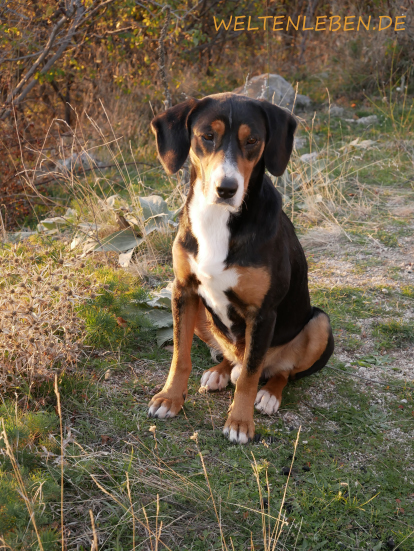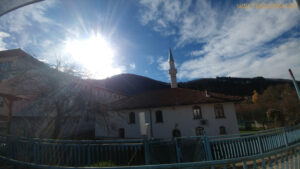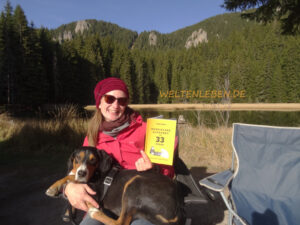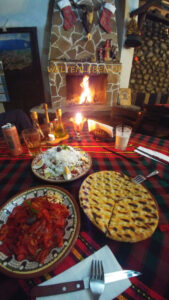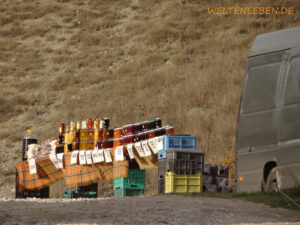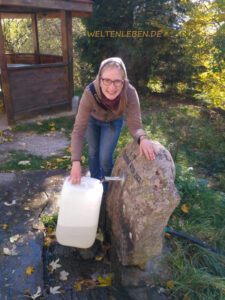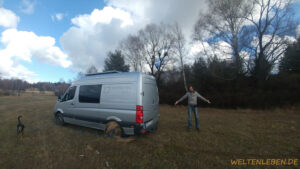We would never have thought that we would find a four-legged companion again in Bulgaria of all places.
Romania had been THE dog country – stray dogs everywhere, in almost every street bay, where the unfortunately unavoidable rubbish collected.
In Bulgaria, too, there are these littered bays, but without dogs. And the free-living dogs we see in cities often have a tag in their ear. This probably means that they have been castrated and vaccinated. Very sensible!
In this respect, dogs we meet are rather a rarity. And yet, at a camping site we are immediately greeted by a pretty tricoloured dog that apparently “lives” here. He is very friendly, curious and trusting. He stays close to us for the next three days, which we spend in this beautiful place. We “sniff” each other out a little and then decide, after a night of rehearsals at Silvio and a trial walk, to move on as a threesome 🙂
We christen him “Tenio” – a real Bulgarian name! And we learn from the vet, to whom we will soon take him, that he is about one year old and probably a real Bulgarian hunting dog! “Ludogorsko Gonche” – in English “crazy forest”. What that means will become clear as soon as we see his super nose in action…so our bundle of energy will soon get another nickname from us: Cheeky-Fratz!
Due to the dog, we change our itinerary a bit and deliberately stay in Bulgaria’s very rural mountain areas.
We spend most of our time in the Rhodope Mountains, which are covered by spruce forests. This is also the border region to Greece, where, funnily enough, it is not possible to cross the border with your own vehicle. We explore the Arda valley in this border region and buy delicious cheese at the dairy “Rhodopa Milk”, whose owner opens her salesroom especially for us.
A little sightseeing is also allowed: Among other things, we marvel at the natural wonder of the “Wonderful Bridges”, huge marble formations that were created naturally ages ago. And the famous Bachkovo Monastery beckons us: we admire its walls, which are painted and decorated all over, including chandeliers and a magnificent altar. Our aesthetic love for Orthodox churches is finally awakened!
Click to open the gallery:
However, there are not only beautiful churches in the Rhodope Mountains. Here we also find mosques in almost every small village. The inhabitants here are indeed mostly Muslim. And with a bit of luck, we may also listen to the chanting of the muezzins a few times. A magical foretaste of the Orient!
During the days of travel, we repeatedly enjoy brief encounters with open-minded locals, which spurs us on to learn to speak some Bulgarian. In fact, at the end of the 9 weeks we can already say a few everyday words and short sentences and even read the Cyrillic script quite passably. This makes it much easier, as we had to dictate written words for translation with “guessed” letters at the beginning, such as “an upside-down R”, “the triangle without a dash at the bottom”, “X with a dash in the middle” and the like 🙂
And if we get stuck with words, hands and feet, there are surprisingly many Bulgarians who speak English compared to the countries we have visited so far.
We also have to rethink the interpretation and use of head nods and shakes: In Bulgaria, the meaning is the opposite of the meaning in Germany, for example. So you should not be surprised if a question is answered with a shake of the head and “da” (“yes”).
Even when reading the menus of the “mexaha” (pronounced “mehana”), the Bulgarian taverns, a little knowledge of writing and words is extremely helpful. In the Rhodope Mountains we discover our preference for Bulgarian cuisine! The menu offers a wide choice, surprisingly many vegetarian dishes, lots of cheese and eggs, many different salads and delicious casseroles and baked meats. For example, we get to know Patatnik. As Chris aptly describes it: “They have grated potatoes, egg and cheese baked into a thin pancake! They just know how to eat!” 🙂 And this variety for usually quite little money. Ingenious!
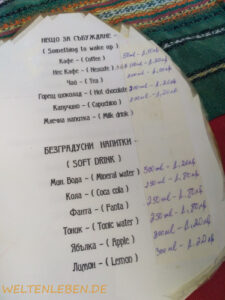
At these prices, it is also possible to stop in spontaneously at lunchtime. (Amount divided by two gives this in euros!)
Another great thing about this time of year is that you can buy home-made jams and various kinds of honey from “mobile” traders at many street bays. Here we discover, for example, black walnut jams and fine berry jams.
And absolutely travel- and people-friendly are the drinking water fountains, which can be found at almost every bend in the road and even sometimes along hiking trails. As a rule, there are also one or two drinking cups ready here so that thirst can be quenched easily. In the Rhodope Mountains in particular, there are often even elaborate picnic areas next to these springs, complete with roofing, seating and sometimes even a barbecue.
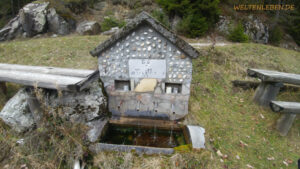
Drinking water springs in various shapes and sizes along paths and roads are part of the picture, especially in the Rhodope Mountains.
We even find toilet facilities at such places and also at parking or parking spaces, in small hutches with a sawn-out outhouse cut-out in the middle. People obviously use them and the surrounding nature stays clean 🙂
The Rhodope Mountains are not only a culinary, food and religious surprise. Also climatically we experience a sensational temperature range of 27 degrees (!), a little later still 21 degrees at 1700 metres above sea level (!) and some time later only 4 degrees…all within the month of November!
For pictorial impressions from the Rhodope Mountains, click on the following richly filled gallery:
Unfortunately, we are now also having our first experience with getting stuck. We drive over an apparently firm meadow – by now it is the beginning of December – and very quickly sink about 15 cm deep in mud. Oh dear!
The only thing that helps is to be creative and push hard in combination with sensitive acceleration…the man does the latter, as he is already a pro at driving our 3.2 tonne vehicle 😉 Thanks to good teamwork and the use of dry tufts of grass, we actually make it out under our own power and continue towards the Pirin Mountains.
We can hardly believe it when, having arrived in the Pirin, we got stuck for the second time after a total of 5 months of travelling within a week and we can’t move.
This time it is the first real snow that traps us. Fully loaded and having to cope with a minimal incline on forest soil in the snow are apparently too much for a heavy vehicle without lock and without all-wheel drive…sad and somewhat disillusioning with regard to possible adventurous future pitch searches. Fortunately, we did not yet know what we were in for when we had taken a wonderful two-hour snow walk right before.
The only thing to do was to push, steer, sweat and swear again (see above for the distribution of roles :-D). This and a new creative use of “snow shovels” (= two approx. 30 cm long logs…) and our sawdust, which is actually intended for use in our dry separation toilet, make it possible that we are “on course” again 75 minutes later. Hooray!
The Pirin region impresses with its pine forests and mountains up to 3000 metres high. There is also one of Bulgaria’s three national parks here, but we only drive around it because of the weather. Winter has really arrived and the Pirin is known as a ski destination, unfortunately often to the detriment of the environment and nature. Primeval forests have to give way, often illegally according to travel guides, and huge hotel villages dominate the picture. Paradoxically, many of them are empty, partly dilapidated or often only half-built.
Traffic seems to be becoming more reckless in the more densely populated Pirin, and rubbish is also on the rise again.
Overall, Bulgaria unfortunately has the biggest rubbish problem compared to the countries on our route so far. Whole river banks and even meadows outside small towns are littered with plastic waste. So much that it is hard to believe and I involuntarily put my hand over my mouth.
A small highlight of the area and our last week in Bulgaria is bathing in the hot springs in Rupite. Or rather, we take a bath in the small thermal bath that belongs to it, in order to enjoy a hot shower again. The water is really pleasantly warm, very welcome given the cold air temperatures around us.
Unfortunately, Bulgaria’s weather god decides that after welcoming us to his country with rain two months ago, he wants to bid us farewell in the same way.
So the last few days, which we actually wanted to spend outside in the beautiful nature around Melnik, become constricted wet foggy days. The low clouds only allow us a brief glimpse of the sandstone mountains we came here to see. Some of them are shaped like pyramids and the rock is very similar to the Rapa Rosie in Romania.
Open the gallery for impressions from the Pirin:
So after a very impressive, very beautiful, but also increasingly exhausting 64 days, we want to say goodbye to Bulgaria. Only that the farewell doesn’t go quite as smoothly as we thought…more about that in the next post!
Until then – have a good time!
Sophia, Chris and Tenio 😉

